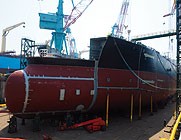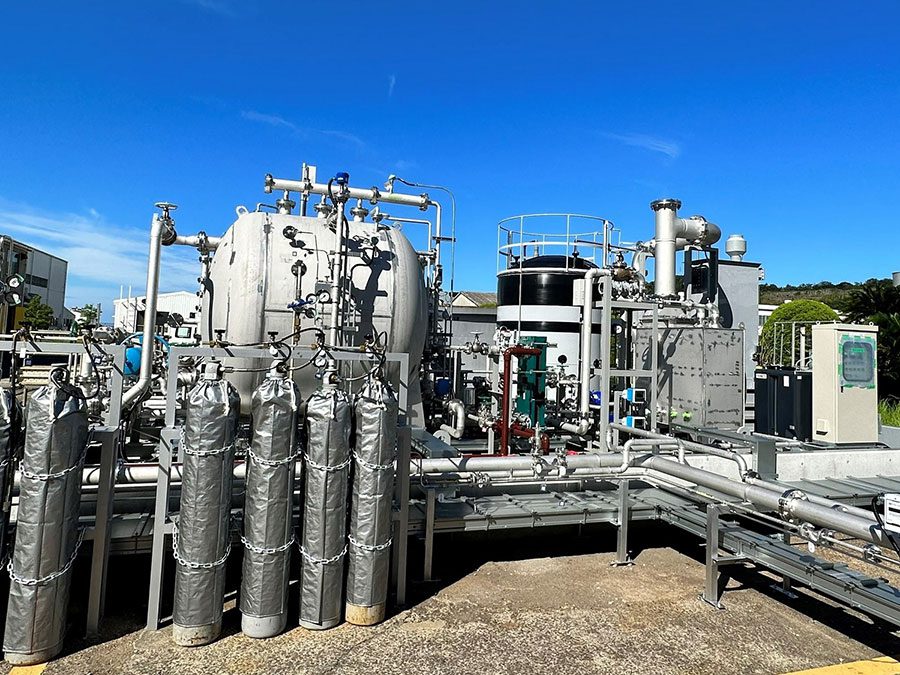 The following article originally appeared in DNV’s Tanker update No. 1 2011.
The following article originally appeared in DNV’s Tanker update No. 1 2011.
by Magne A. Røe, DNV
The Hyundai group of shipyards has the combined capacity to produce 200 new vessels per year. Basically, that means a ship naming ceremony every other working day.
The yards have some 89,000 workers, which is enough to populate a fair-sized city. Hyundai Heavy Industries is definitely the world’s number one ship builder and has one big company goal: to strengthen and maintain this position. This ambition does not come for free and a key success factor is to stay at the forefront of technical achievements. We have been invited to discuss this with Mr Jong-Seung Lee, Senior Vice President at the Basic Design Office, Shipbuilding Division.
Are there any trends that may have a major impact on how ships will be designed and built in the future?
Energy efficient due to GHG requirement and higher fuel prices and the environmental requirements are getting tougher. This translates into new ship designs. One of the answers is to utilise larger ships and Maersk’s 18,000 TEU Triple E container ship is a good example of this. Especially container ships will become larger and I estimate we will see ships of up to 20,000 TEU in the future. Ships of that size will of course have some consequences for the port operators, as the infrastructure in and around ports will have to be adapted to cater for them.
Another trend is the increase in Chinese shipbuilding capacity as the government wants goods to and from China to be transported on Chinese ships and has a policy stating this. The capacity of the Chinese yards will be reduced by a couple of percentage points over the next few years, but in the longer term I expect this to change. Traditionally, China has built tankers and bulk carriers, but I expect to see more container ships as well from Chinese yards. Accordingly we will also expand more into passenger ship and the offshore markets through close cooperation together with Shipbuilding division and Offshore division.
What are some of the major initiatives HHI has taken in eco-ship development? What actions has HHI taken to help reduce the environmental footprint?
We carry out many model tests in-house model basin which give us well constructed data base useful. In the case of container ships, we have looked into slow design speed and variable draught so called operating profile in due course of a new hull form development with, for example, a wider beam. This will lead to improved stability. During operations, we can reduce the ballast to a minimum. The main engine is to be dual MCR and/or low rpm to propeller efficiency improvement as well as various tuning applied depends on the client’s operation pattern.
Specifically, we are working on different energy saving aspects. For example, thruster fins designed to move the water flow more bettery towards the propeller which is efficientlty designed as Vs propeller. A new X-twist rudder design and these two will reduce the power required by around two per cent each. We are also developing a contra-rotating propeller and here the energy saving is above ten per cent. The pre-swirl duct which is under developmentis another initiative that will work in co-existence with other activities. This is a technologically very complicated solution, but the energy savings are quite substantial.
When looking at the new EEDI requirements being implemented by IMO – what are you doing to help ship owners comply with these new requirements?
In addition to the other activities I mentioned, we consider waste heat recovery system with power take-in shaft generator and frequency controlled pump motor and LED light and AMP (Alternative means of power). We see that LNG is a suitable fuel as alternative since the EEDI success rate will be heavily dependent on GHG foot print. Reducing the speed from, for instance, 16.5 to 15.5 knots for VLCC is going to help much in achieving compliance with EEDI.
There is also the issue of ballast water, and we have done calculations on this in the past too and found that minimum ballast requirements will probably be the right answer as opposed to ballast-free which is, we think, the cost/benefit will also have to be weighed up in terms of payback time for a more expensive ship for the owners. When DNV came up with the ballast-free Triality concept last year, I sent our designers back to the drawing board and we concluded that a ship hull design with low-ballast requirements would be less expensive to build.
So in your view the introduction of LNG in the propulsion system will be a good solution?
Yes, the sooner the better. Our engine division is working on thin addition to technologies to reduce NOx emissions by 2015 and provide effective SOx scrubbers. But LNG will be the big picture answer. We are working on LNG Joint Industry Projects with, among others, Wärtsilä in order to develop a dual fuel engine and then purer LNG with gas injection (ME-GI). Also we have developed our own Gas Supply System and tank system which are design optimized in view of safety and economy. DNV’s Quantum design concept is another JIP we are working on with DNV right now to create an LNG-fuelled 9,700 TEU container ship. In addition to that we have already developed LNG fuelled tankers with ME-GI and/or dual fuel engine.
Smart ships have been mentioned as well. Can you please elaborate on this?
IMO clearly states that E-navigation is the requirement of the future. Here we have developed a smart ship system (Intteligence for remote monitoring and control service) using ship area network which was onboard applied for our client Maersk Line 4,500 TEU container vessel. Our electro and electronic division is working on this, and we are in contact with very many manufacturers of equipment and software to make this work and ensure that ship-based software systems are optimised in the interface between different supplier’s systems. Along the same lines is the ISDS notation for the offshore industry, where DNV is currently testing out the hardware needed. Even though these systems are of no obvious benefit to us as a shipbuilder, we are eager to handle this for our customers.
Finally, what are your expectations of DNV?
To provide recommendations and advice. I expect DNV not just to review but also to come up with clear advice and recommendations on how to improve ship designs as well as to act as an expert consultant. Yes, DNV also has a class hat to wear, but as such I still expect open communication regarding the how to. It must also provide guidance on future IMO requirements to ensure that all requirements are met so that we can practically applied. Thanks to DNV, the issues of ballast-free ships and LNG as propulsion and the consequent focus on LNG distribution and availability are important elements in our daily discussions.
Source: DNV

 Join The Club
Join The Club



![Hyundai provides a quarter of the world’s total shipbuilding capacity [INTERVIEW]](https://gcaptain.com/wp-content/uploads/2011/07/hyundai-yard-181x140L_tcm4-463262.jpg)







